Item:
Bucky Fuller on the
Great Pirates
What follows is an extended excerpt
from R Buckminster Fuller's book "Operating Manual for Spaceship
Earth." It illustrates his all-encompassing vision of the
history of politics on Earth... and more importantly... the
ramifications of it. Section titles are courtesy of Tek-Gnostics.
Hidden Power – Rise of the
Great Seafarers
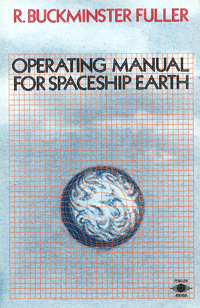 Looking at the total historical pattern of man around the
Earth and observing that three quarters of the Earth is water, it
seems obvious why men thought of themselves exclusively as
pedestrians (dry land specialists). Confined to the quarter of the
Earth's surface which is dry land it is easy to see how they came to
specialize further as farmers or hunters-or, commanded by their
leader, became specialized as soldiers. Less than half of the dry 25
per cent of the Earth's surface was immediately favorable to the
support of human life. Thus, throughout history 99.9% of humanity
has occupied only 10% of the total Earth surface, dwelling only
where life support was visibly obvious. The favorable land was not
in one piece, but consisted of a myriad of relatively small parcels
widely dispersed over the surface of the enormous Earth sphere. The
small isolated groups of humanity were utterly unaware of one
another's existence. They were everywhere ignorant of the vast
variety of very different environments and resource patterns
occurring other than where they dwelt.
Looking at the total historical pattern of man around the
Earth and observing that three quarters of the Earth is water, it
seems obvious why men thought of themselves exclusively as
pedestrians (dry land specialists). Confined to the quarter of the
Earth's surface which is dry land it is easy to see how they came to
specialize further as farmers or hunters-or, commanded by their
leader, became specialized as soldiers. Less than half of the dry 25
per cent of the Earth's surface was immediately favorable to the
support of human life. Thus, throughout history 99.9% of humanity
has occupied only 10% of the total Earth surface, dwelling only
where life support was visibly obvious. The favorable land was not
in one piece, but consisted of a myriad of relatively small parcels
widely dispersed over the surface of the enormous Earth sphere. The
small isolated groups of humanity were utterly unaware of one
another's existence. They were everywhere ignorant of the vast
variety of very different environments and resource patterns
occurring other than where they dwelt.
But there were a few human beings who gradually, through the
process of invention and experiment, built and operated, first…
local river and bay, next… along-shore, then… off-shore rafts,
dugouts, grass boats, and outrigger sailing canoes. Finally, they
developed voluminous rib-bellied fishing vessels, and thereby
ventured out to sea for progressively
longer periods. Developing ever larger and more capable ships, the
seafarers eventually were able to remain for months on the high
seas. Thus, these venturers came to live normally at sea. This led
them inevitably into world-around, swift, fortune-producing
enterprise. Thus they became the first world men.
The men who were able to establish themselves on the oceans
had also to be extraordinarily effective with the sword upon both
land and sea. Here we see the specialization being greatly amplified
under the supreme authority of the comprehensively visionary and
brilliantly co-ordinated top swordsman, sea venturer. If his "ship
came in" — that is, returned safely from its years' long venturing —
all the people in his realm prospered and their leader's power was
vastly amplified.
There were very few of these top power men. But as they went
on their sea ventures they gradually found that the waters
interconnected all the world's people and lands. The
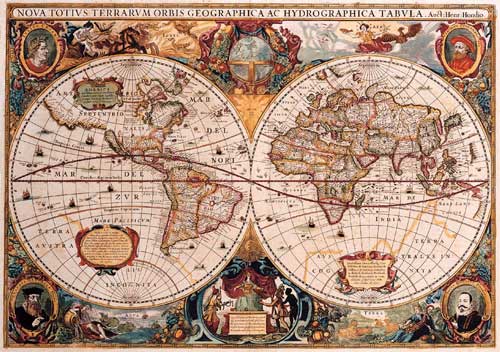 sea masters
soon found that the people in each of the different places visited
knew nothing of people in other places. The great venturers found
the resources of Earth very unevenly distributed, and discovered
that by bringing together various resources occurring remotely from
one another one complemented the other in producing tools, services,
and consumables of high advantage and value. Thus resources in one
place which previously had seemed to be absolutely worthless
suddenly became highly valued. Enormous wealth was generated by what
the sea venturers could do in the way of integrating resources and
distributing the products to the, everywhere around the world,
amazed and eager customers. So these very few masters of the water
world became incalculably rich and powerful.
sea masters
soon found that the people in each of the different places visited
knew nothing of people in other places. The great venturers found
the resources of Earth very unevenly distributed, and discovered
that by bringing together various resources occurring remotely from
one another one complemented the other in producing tools, services,
and consumables of high advantage and value. Thus resources in one
place which previously had seemed to be absolutely worthless
suddenly became highly valued. Enormous wealth was generated by what
the sea venturers could do in the way of integrating resources and
distributing the products to the, everywhere around the world,
amazed and eager customers. So these very few masters of the water
world became incalculably rich and powerful.
The great sea venturers thought always in terms of the world,
because the world's waters are continuous and cover three-quarters
of the Earth planet. This meant that before the invention and use of
the radio, 99.9% of humanity thought only in the terms of their own
local terrain. Despite our recently developed communications
intimacy and popular awareness of total Earth, we too are as yet
politically organized entirely in the terms of exclusive and utterly
obsolete sovereign separateness.
Nationalism - The Rise of the
Illuminati
Under these everyday, knowledge-thwarting or limiting
circumstances of humanity, the comprehensively-informed master
venturers of history who went to sea soon realized that the only
real competition they had was that of other powerful outlaws who
might also know or hope to learn through experience "what it is all
about." I call these sea mastering people the great outlaws or Great
Pirates — the G. P.'s — simply because the arbitrary laws enacted or
edicted by men on the land could not be extended effectively to
control humans beyond their shores and out upon the seas. So the
world men who lived on the seas were inherently outlaws, and the
only laws that could and did rule them were the natural laws-the
physical laws of universe which when tempestuous were often cruelly
devastating. High seas combined with nature's fog and night-hidden
rocks were uncompromising.
And it followed that these Great Pirates came into mortal
battle with one another to see who was going to control the vast sea
routes and eventually the world. Their battles took place out of
sight of landed humanity. Most of the losers went to the bottom
utterly unbeknownst to historians. Those who stayed on the top of
the waters and prospered did so because of their comprehensive
capability. That is they were the antithesis of specialists. They
had high proficiency in dealing with celestial navigation, the
storms, the sea, the men, the ship, economics, biology, geography,
history, and science. The wider and more long-distanced their
anticipatory strategy, the more successful they became.
But these hard, powerful, brilliantly resourceful sea masters
had to sleep occasionally, and therefore found it necessary to
surround themselves with super-loyal, muscular but dull-brained
illiterates who could not see nor savvy their masters' stratagems.
There was great safety in the mental dullness of these henchmen. The
Great Pirates realized that the only people who could possibly
contrive to displace them were the truly bright people. For this
reason their number one strategy was secrecy. If the other powerful
pirates did not know where you were going, nor when you had gone,
nor when you were coming back, they would not know how to waylay
you. If anyone knew when you were coming home, "small-timers" could
come out in small boats and waylay you in the dark and take you
over-just before you got home tiredly after a two-year
treasure-harvesting voyage. Thus hijacking and second-rate piracy
became a popular activity around the world's shores and harbors.
Thus secrecy became the essence of the lives of the successful
pirates; ergo, how little is known today of that which I am
relating.
 Leonardo da Vinci is the outstanding example of the
comprehensively anticipatory design scientist. Operating under the
patronage of the Duke of Milan he designed the fortified defenses
and weaponry as well as the tools of peaceful production. Many other
great military powers had their comprehensive design
scientist-artist inventors; Michelangelo was another of them.
Leonardo da Vinci is the outstanding example of the
comprehensively anticipatory design scientist. Operating under the
patronage of the Duke of Milan he designed the fortified defenses
and weaponry as well as the tools of peaceful production. Many other
great military powers had their comprehensive design
scientist-artist inventors; Michelangelo was another of them.
Many persons wonder why we do not have such men today. It is a
mistake to think we cannot. What happened at the time of Leonardo
and Galileo was that mathematics was so improved by the advent of
the zero that not only was much more scientific shipbuilding made
possible but also much more reliable navigation. Immediately
thereafter truly large-scale venturing on the world's oceans
commenced, and the strong sword-leader patrons as admirals put their
Leonardos to work, first in designing their new and more powerful
world-girdling ships. Next they took their Leonardos to sea with
them as their “seagoing Merlins” to invent ever more powerful tools
and strategies on a world-around basis to implement their great
campaigns to best all the other great pirates, thereby enabling them
to become masters of the world and of all its people and wealth. The
required and scientifically designed secrecy of the sea operations
thus pulled a curtain that hid the Leonardos from public view,
popular ken, and recorded history.
Finally, the sea-dwelling Leonardos became Captains of the
ships or even Admirals of Fleets, or Commandants of the Navy yards
where they designed and built the fleets, or they became the
commandants of the naval war colleges where they designed and
developed the comprehensive strategy for running the world for a
century to come. This included not only the designing of the network
of world-around voyaging and of the ships for each task but also the
designing of the industrial establishments and world-around mining
operations and naval base-building for production and maintenance of
the ships.
This Leonardo-type planning inaugurated today's large-scale,
world-around industrialization's vast scale of thinking. When the
Great Pirates came to building steel steamships and blast furnaces
and railroad tracks to handle the logistics, the Leonardos appeared
momentarily again in such men as Telford who built the railroads,
tunnels, and bridges of England, as well as the first great
steamship.
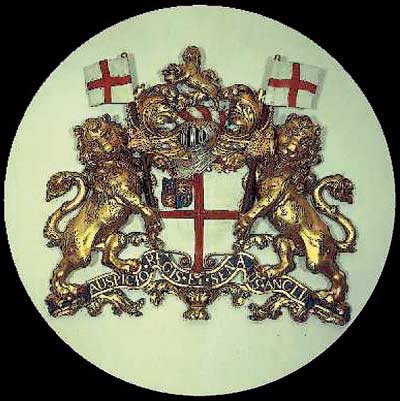 You may say, "Aren't you talking about the British Empire?" I
answer, No… the so-called British Empire was a manifest of the
world-around misconception of who ran things and a disclosure of the
popular ignorance of the Great Pirates' absolute world-controlling
through their local-stooge sovereigns and their prime ministers, as
only innocuously and locally modified here and there by the separate
sovereignties' internal democratic processes. As we soon shall see,
the British Isles lying off the coast of Europe constituted in
effect a fleet of unsinkable ships and naval bases commanding all
the great harbors of Europe. Those islands were the possession of
the topmost Pirates. Since the Great Pirates were building,
maintaining, supplying their ships on those islands, they also
logically made up their crews out of the native islanders who were
simply seized or commanded aboard by imperial edict. Seeing these
British Islanders aboard the top pirate ships the people around the
world mistakenly assumed that the world conquest by the Great
Pirates was a conquest by the will, ambition, and organization of
the British people.
You may say, "Aren't you talking about the British Empire?" I
answer, No… the so-called British Empire was a manifest of the
world-around misconception of who ran things and a disclosure of the
popular ignorance of the Great Pirates' absolute world-controlling
through their local-stooge sovereigns and their prime ministers, as
only innocuously and locally modified here and there by the separate
sovereignties' internal democratic processes. As we soon shall see,
the British Isles lying off the coast of Europe constituted in
effect a fleet of unsinkable ships and naval bases commanding all
the great harbors of Europe. Those islands were the possession of
the topmost Pirates. Since the Great Pirates were building,
maintaining, supplying their ships on those islands, they also
logically made up their crews out of the native islanders who were
simply seized or commanded aboard by imperial edict. Seeing these
British Islanders aboard the top pirate ships the people around the
world mistakenly assumed that the world conquest by the Great
Pirates was a conquest by the will, ambition, and organization of
the British people.
Thus was the G. P.'s grand deception victorious.
But the people of those islands never had the ambition to go
out and conquer the world. As a people they were manipulated by the
top pirates and learned to cheer as they were told of their nation's
world prowess.
The topmost Great Pirates' Leonardos discovered-both in their
careful, long-distance planning and in their anticipatory inventing
— that the grand strategies of sea power made it experimentally
clear that a plurality of ships could usually outmaneuver one ship.
So the Great Pirates' Leonardos invented navies. Then, of course,
they had to control various resource-supplying mines, forests, and
lands with which and upon which to build the ships and establish the
industries essential to building, supplying, and maintaining their
navy's ships.
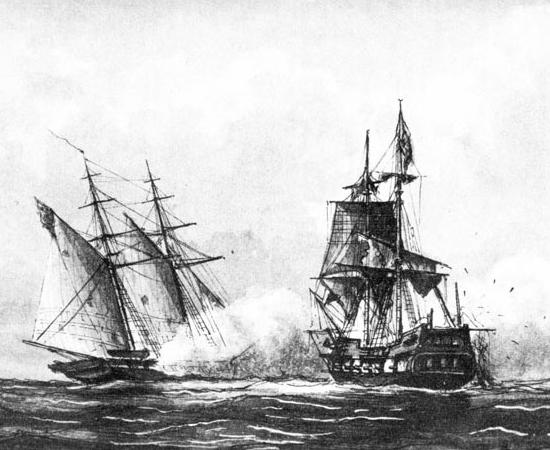 Then came the grand strategy which said… "divide and conquer."
You divide up the other man's ships in battle or you best him when
several of his ships are hauled out on the land for repairs. They
also had a grand strategy of anticipatory divide and conquer.
Anticipatory divide and conquer was much more effective than tardy
divide and conquer, since it enabled those who employed it to
surprise the other pirate under conditions unfavorable to the
latter, So the great top pirates of the world, realizing that dull
people were innocuous and that the only people who could contrive to
displace the supreme pirates were the bright ones, set about to
apply their grand strategy of anticipatory divide and conquer to
solve that situation comprehensively.
Then came the grand strategy which said… "divide and conquer."
You divide up the other man's ships in battle or you best him when
several of his ships are hauled out on the land for repairs. They
also had a grand strategy of anticipatory divide and conquer.
Anticipatory divide and conquer was much more effective than tardy
divide and conquer, since it enabled those who employed it to
surprise the other pirate under conditions unfavorable to the
latter, So the great top pirates of the world, realizing that dull
people were innocuous and that the only people who could contrive to
displace the supreme pirates were the bright ones, set about to
apply their grand strategy of anticipatory divide and conquer to
solve that situation comprehensively.
The Great Pirate came into each of the various lands where he
either acquired or sold goods profitably and picked the strongest
man there to be his local head man. The Pirate's picked man became
the Pirate's general manager of the local realm. If the Great
Pirate's local strong man in a given land had not already done so,
the Great Pirate told him to proclaim himself king. Despite the
local head man's secret subservience to him, the Great Pirate
allowed and counted upon his king-stooge to convince his countrymen
that he, the local king, was indeed the head man of all men — the
god-ordained ruler. To guarantee that sovereign claim the Pirates
gave their stooge-kings secret lines of supplies which provided
everything required to enforce the sovereign claim. The more
massively bejeweled the kings gold crown, and the more visible his
court and castle, the less visible was his pirate master.
The Great Pirates said to all their lieutenants around the
world, "Any time bright young people show up, I'd like to know about
it, because we need bright men." So each time the Pirate came into
port the local king-ruler would mention that he had some bright,
young men whose capabilities and thinking shone out in the
community. The Great Pirate would say to the king, "All right, you
summon them and deal with them as follows: As each young man is
brought forward you say to him, 'Young man, you are very bright. I'm
going to assign you to a great history tutor and in due course… if
you study well and learn enough… I'm going to make you my Royal
Historian, but you've got to pass many examinations by both your
teacher and myself.'" And when the next bright boy was brought
before him the King was to say, "I'm going to make you my Royal
Treasurer," and so forth. Then the Pirate said to the king, "You
will finally say to all of them: But each of you must mind your own
business or off go your heads. I'm the only one who minds
everybody's business.' "
 And this is the way schools began — as the royal tutorial
schools.
And this is the way schools began — as the royal tutorial
schools.
You realize, I hope, that I am not being facetious. That is
it. This is the beginning of schools and colleges and the beginning
of intellectual specialization. Of course, it took great wealth to
start schools, to have great teachers, and to house, clothe, feed,
and cultivate both teachers and students. Only the
Great-Pirate-protected robber-barons and the Pirate-protected and
secret intelligence-exploited international religious organizations
could afford such scholarship investment. And the development of the
bright ones into specialists gave the king very great brain power,
and made him and his kingdom the most powerful in the land and thus,
secretly and greatly, advantaged his patron Pirate in the world
competition with the other Great Pirates.
But specialization is in fact only a fancy form of slavery
wherein the "expert" is fooled into accepting his slavery by making
him feel that in return he is in a socially and culturally
preferred, ergo, highly secure, lifelong position. But only the
king's son received the Kingdom-wide scope of training.
However, the big thinking in general of a spherical Earth and
celestial navigation was retained exclusively by the Great Pirates,
in contradistinction to a four-cornered, flat world concept, with
empire and kingdom circumscribed knowledge, constricted to only that
which could be learned through localized preoccupations. Knowledge
of the world and its resources was enjoyed exclusively by the Great
Pirates, as were also the arts of navigation, shipbuilding and
handling, and of grand logistical strategies and of
nationally-undetectable, therefore effectively deceptive,
international exchange media and trade balancing tricks by which the
top pirate, as (in gambler's parlance) "the house," always won.
Modern Science – The fall of
the Illuminati
Then there came a time, which was World War I, when the most
powerful out-pirates challenged the in-pirates with the scientific
and technological innovation of an entirely new geometry of
thinking. The out-pirates’ attack went under and
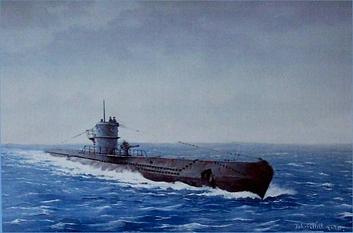 above the sea
surface and into the invisible realm of electronics and chemical warfaring. Caught off-guard, the in-pirates, in order to save
themselves, had to allow their scientists to go to work on their own
inscrutable terms. Thus, in saving themselves, the Great Pirates
allowed the scientists to plunge their grand, industrial logistics,
support strategy into the vast ranges of the electro-magnetic
spectrum that were utterly invisible to the pirates.
above the sea
surface and into the invisible realm of electronics and chemical warfaring. Caught off-guard, the in-pirates, in order to save
themselves, had to allow their scientists to go to work on their own
inscrutable terms. Thus, in saving themselves, the Great Pirates
allowed the scientists to plunge their grand, industrial logistics,
support strategy into the vast ranges of the electro-magnetic
spectrum that were utterly invisible to the pirates.
The pirates until then had ruled the world through their
extraordinarily keen senses. They judged things for themselves, and
they didn't trust anyone else's eyes. They trusted only that which
they could personally smell, hear, touch, or see. But the Great
Pirates couldn't see what was going on in the vast ranges of the
electro-magnetic reality. Technology was going from wire to
wireless, from track to trackless, from pipe to pipeless, and from
visible structural muscle to the invisible chemical element
strengths of metallic alloys and electro-magnetics.
The Great Pirates came out of that “first world war” unable to
cope knowledgeably with what was going on in the advanced scientific
frontiers of industry. The pirates delegated inspection to their
"troubleshooter" experts, but had to content themselves with relayed
second-hand information. This forced them to appraise blindly-ergo,
only opinionatedly — whether this or that man really knew what he
was talking about, for the G. P.'s couldn't judge for themselves.
Thus the Great Pirates were no longer the masters. That was the end.
The Great Pirates became extinct. But because the G. P.'s had always
operated secretly, and because they hoped they were not through,
they of course did not announce or allow it to be announced that
they were extinct. And because the public had never known of them
and had been fooled into thinking of their kingly stooges and local
politicians as being in reality the head men, society was… and is…
as yet unaware either that the Great Pirates once ran the world or
that they are now utterly extinct.
Though the pirates are extinct, all of our international trade
balancing and money ratings, as well as all economic accounting, in
both the capitalistic and communistic countries, hold strictly to
the rules, value systems, terminology, and concepts established by
those Great Pirates. Powerful though many successors to the Great
Pirates' fragmented dominions may be, no one government, religion,
or enterprise now holds the world's physical or metaphysical
initiatives.
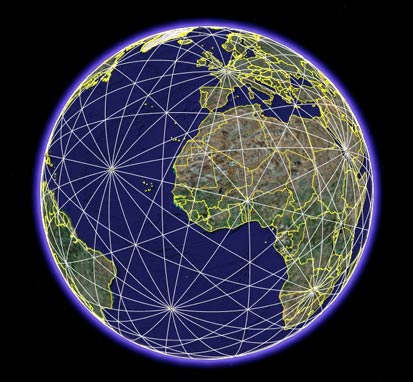
The New Paradigm
The metaphysical initiative, too, has gone into competitive
confusion between old religions and more recent political or
scientific ideologies. These competitors are already so heavily
weighted with physical investments and proprietary expediencies as
to vitiate (impair) any metaphysical initiative. A new, physically
uncompromised, metaphysical initiative of unbiased integrity could
unify the world. It could… and probably will be provided by the
utterly impersonal problem solutions of the computers (and the
internet). Only to their superhuman range of calculative
capabilities can and may all political, scientific, and religious
leaders face-savingly acquiesce.
Abraham Lincoln's concept of "right triumphing over might" was
realized when Einstein… as metaphysical intellect… wrote the
equation of physical universe E = Mc2 and thus comprehended it. Thus
the metaphysical took the measure of, and mastered, the physical.
That relationship seems by experience to be irreversible. Nothing in
our experience suggests that energy could comprehend and write the
equation of intellect. That equation is operating inexorably, and
the metaphysical is now manifesting its ability to reign over the
physical.
This is the essence of human evolution upon Spaceship Earth.
If the present planting of humanity upon Spaceship Earth cannot
comprehend this inexorable process and discipline itself to serve
exclusively that function of metaphysical mastering of the physical
it will be discontinued, and its potential mission in universe will
be carried on by the metaphysically endowed capabilities of other
beings on other spaceship planets of universe.
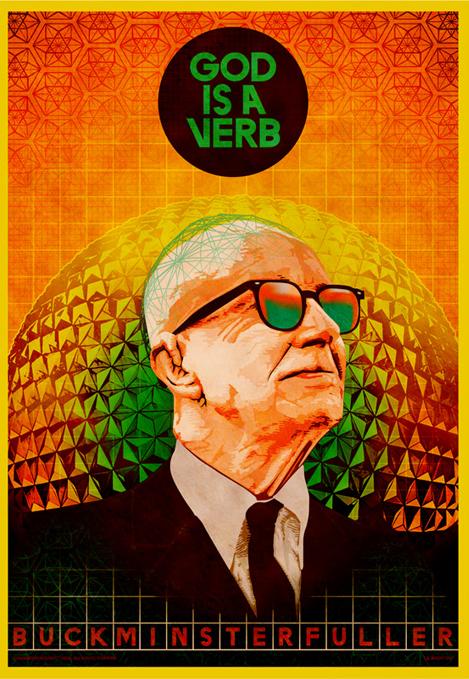



 Looking at the total historical pattern of man around the
Earth and observing that three quarters of the Earth is water, it
seems obvious why men thought of themselves exclusively as
pedestrians (dry land specialists). Confined to the quarter of the
Earth's surface which is dry land it is easy to see how they came to
specialize further as farmers or hunters-or, commanded by their
leader, became specialized as soldiers. Less than half of the dry 25
per cent of the Earth's surface was immediately favorable to the
support of human life. Thus, throughout history 99.9% of humanity
has occupied only 10% of the total Earth surface, dwelling only
where life support was visibly obvious. The favorable land was not
in one piece, but consisted of a myriad of relatively small parcels
widely dispersed over the surface of the enormous Earth sphere. The
small isolated groups of humanity were utterly unaware of one
another's existence. They were everywhere ignorant of the vast
variety of very different environments and resource patterns
occurring other than where they dwelt.
Looking at the total historical pattern of man around the
Earth and observing that three quarters of the Earth is water, it
seems obvious why men thought of themselves exclusively as
pedestrians (dry land specialists). Confined to the quarter of the
Earth's surface which is dry land it is easy to see how they came to
specialize further as farmers or hunters-or, commanded by their
leader, became specialized as soldiers. Less than half of the dry 25
per cent of the Earth's surface was immediately favorable to the
support of human life. Thus, throughout history 99.9% of humanity
has occupied only 10% of the total Earth surface, dwelling only
where life support was visibly obvious. The favorable land was not
in one piece, but consisted of a myriad of relatively small parcels
widely dispersed over the surface of the enormous Earth sphere. The
small isolated groups of humanity were utterly unaware of one
another's existence. They were everywhere ignorant of the vast
variety of very different environments and resource patterns
occurring other than where they dwelt. sea masters
soon found that the people in each of the different places visited
knew nothing of people in other places. The great venturers found
the resources of Earth very unevenly distributed, and discovered
that by bringing together various resources occurring remotely from
one another one complemented the other in producing tools, services,
and consumables of high advantage and value. Thus resources in one
place which previously had seemed to be absolutely worthless
suddenly became highly valued. Enormous wealth was generated by what
the sea venturers could do in the way of integrating resources and
distributing the products to the, everywhere around the world,
amazed and eager customers. So these very few masters of the water
world became incalculably rich and powerful.
sea masters
soon found that the people in each of the different places visited
knew nothing of people in other places. The great venturers found
the resources of Earth very unevenly distributed, and discovered
that by bringing together various resources occurring remotely from
one another one complemented the other in producing tools, services,
and consumables of high advantage and value. Thus resources in one
place which previously had seemed to be absolutely worthless
suddenly became highly valued. Enormous wealth was generated by what
the sea venturers could do in the way of integrating resources and
distributing the products to the, everywhere around the world,
amazed and eager customers. So these very few masters of the water
world became incalculably rich and powerful. Leonardo da Vinci is the outstanding example of the
comprehensively anticipatory design scientist. Operating under the
patronage of the Duke of Milan he designed the fortified defenses
and weaponry as well as the tools of peaceful production. Many other
great military powers had their comprehensive design
scientist-artist inventors; Michelangelo was another of them.
Leonardo da Vinci is the outstanding example of the
comprehensively anticipatory design scientist. Operating under the
patronage of the Duke of Milan he designed the fortified defenses
and weaponry as well as the tools of peaceful production. Many other
great military powers had their comprehensive design
scientist-artist inventors; Michelangelo was another of them. You may say, "Aren't you talking about the British Empire?" I
answer, No… the so-called British Empire was a manifest of the
world-around misconception of who ran things and a disclosure of the
popular ignorance of the Great Pirates' absolute world-controlling
through their local-stooge sovereigns and their prime ministers, as
only innocuously and locally modified here and there by the separate
sovereignties' internal democratic processes. As we soon shall see,
the British Isles lying off the coast of Europe constituted in
effect a fleet of unsinkable ships and naval bases commanding all
the great harbors of Europe. Those islands were the possession of
the topmost Pirates. Since the Great Pirates were building,
maintaining, supplying their ships on those islands, they also
logically made up their crews out of the native islanders who were
simply seized or commanded aboard by imperial edict. Seeing these
British Islanders aboard the top pirate ships the people around the
world mistakenly assumed that the world conquest by the Great
Pirates was a conquest by the will, ambition, and organization of
the British people.
You may say, "Aren't you talking about the British Empire?" I
answer, No… the so-called British Empire was a manifest of the
world-around misconception of who ran things and a disclosure of the
popular ignorance of the Great Pirates' absolute world-controlling
through their local-stooge sovereigns and their prime ministers, as
only innocuously and locally modified here and there by the separate
sovereignties' internal democratic processes. As we soon shall see,
the British Isles lying off the coast of Europe constituted in
effect a fleet of unsinkable ships and naval bases commanding all
the great harbors of Europe. Those islands were the possession of
the topmost Pirates. Since the Great Pirates were building,
maintaining, supplying their ships on those islands, they also
logically made up their crews out of the native islanders who were
simply seized or commanded aboard by imperial edict. Seeing these
British Islanders aboard the top pirate ships the people around the
world mistakenly assumed that the world conquest by the Great
Pirates was a conquest by the will, ambition, and organization of
the British people.  Then came the grand strategy which said… "divide and conquer."
You divide up the other man's ships in battle or you best him when
several of his ships are hauled out on the land for repairs. They
also had a grand strategy of anticipatory divide and conquer.
Anticipatory divide and conquer was much more effective than tardy
divide and conquer, since it enabled those who employed it to
surprise the other pirate under conditions unfavorable to the
latter, So the great top pirates of the world, realizing that dull
people were innocuous and that the only people who could contrive to
displace the supreme pirates were the bright ones, set about to
apply their grand strategy of anticipatory divide and conquer to
solve that situation comprehensively.
Then came the grand strategy which said… "divide and conquer."
You divide up the other man's ships in battle or you best him when
several of his ships are hauled out on the land for repairs. They
also had a grand strategy of anticipatory divide and conquer.
Anticipatory divide and conquer was much more effective than tardy
divide and conquer, since it enabled those who employed it to
surprise the other pirate under conditions unfavorable to the
latter, So the great top pirates of the world, realizing that dull
people were innocuous and that the only people who could contrive to
displace the supreme pirates were the bright ones, set about to
apply their grand strategy of anticipatory divide and conquer to
solve that situation comprehensively. And this is the way schools began — as the royal tutorial
schools.
And this is the way schools began — as the royal tutorial
schools. above the sea
surface and into the invisible realm of electronics and chemical warfaring. Caught off-guard, the in-pirates, in order to save
themselves, had to allow their scientists to go to work on their own
inscrutable terms. Thus, in saving themselves, the Great Pirates
allowed the scientists to plunge their grand, industrial logistics,
support strategy into the vast ranges of the electro-magnetic
spectrum that were utterly invisible to the pirates.
above the sea
surface and into the invisible realm of electronics and chemical warfaring. Caught off-guard, the in-pirates, in order to save
themselves, had to allow their scientists to go to work on their own
inscrutable terms. Thus, in saving themselves, the Great Pirates
allowed the scientists to plunge their grand, industrial logistics,
support strategy into the vast ranges of the electro-magnetic
spectrum that were utterly invisible to the pirates.
